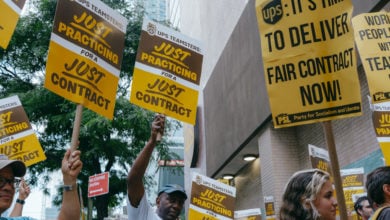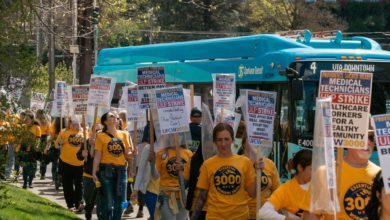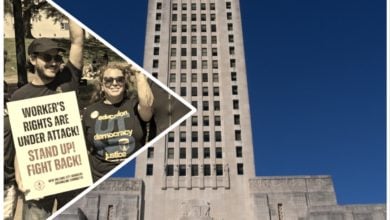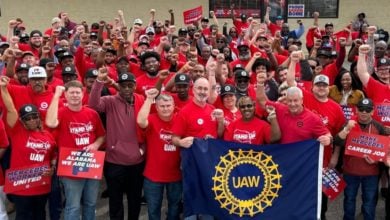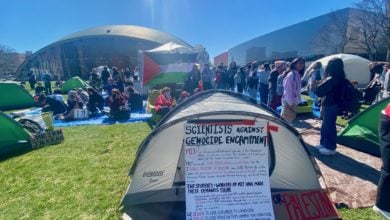On July 25, United Parcel Service and the International Brotherhood of Teamsters announced a tentative agreement six days before the current collective bargaining agreement was set to expire. A potential strike of 340,000 Teamsters, which would have happened on August 1, would have been the largest work stoppage against a single employer in the history of the United States.
The new tentative agreement that we won is the most lucrative contract in UPS Teamsters history. All UPS Teamsters are getting a raise of at least $7.50/hr over the course of the five-year agreement. Part-timers who make up a majority of UPS workers will see their base wages without market rate adjustments increase between 33% and 55%, depending on seniority over the duration of the contract.
The hated two-tier wage system for drivers that was implemented during the 2018 contract, known in the company as “22.4s,” is abolished. All 22.4 drivers will be put into the same wage scale as regular package car drivers and see their wages more than double as they reach top rate. They will also see the same protections against forced overtime that regular package car drivers receive.
Martin Luther King Day is a paid holiday for UPS workers for the first time. The new contract ends forced overtime on workers’ days off — no forced 6th and 7th punches. Drivers will finally have air conditioning in delivery trucks. Other key gains include limiting the abuse of personal vehicle drivers who are subcontracted during the busy holiday season to perform union-member work, stronger protections against heat-related injuries, and the creation of 7,500 new full-time jobs.
How did the Teamsters achieve this?
After two decades of relentless attacks by the company and concessionary contracts, UPS Teamsters were fed up. We were ready for change and most importantly ready to fight for that change. In 2021, with a landslide 2-to-1 margin, Teamsters elected Sean O’Brien and Fred Zuckerman’s slate to lead the union in a new, more militant direction. With new leadership in place in 2022, UPS Teamsters started to gear up for the upcoming contract campaign.
Rallies were held on August 1, 2022, to celebrate the 25th anniversary of the 1997 Teamster strike at UPS, the last time there was a strike at the company. A new UPS Teamster app was released to help coordinate nationwide actions and to keep members regularly updated on the bargaining process. We were getting ready for a fight a potential strike one year in advance and would continue escalating actions for the next year.
In the fall, membership surveys were released and collected. Teamster locals across the country held membership proposal meetings to discuss the core issues and build unity around what we would be fighting for.
In January 2023, rallies were held against excessive overtime. We held additional rallies on MLK Day to make UPS “deliver on the dream.” With eight months to go before the contract was set to expire, UPS and the union sat down for negotiations on regional supplements. Major rallies were being held whenever a new round of negotiations started at UPS warehouses nationwide.
It quickly became clear that UPS was not going to cave to our demands without some serious pressure. With our core demands set, our energies turned to strengthening the organizational structure that could move the hundreds of thousands of our coworkers across the country to action around our demands. After all, we weren’t going to win by just filling out a survey, but by showing the company that we were ready to strike if need be. In every corner of the country, we grew our Contract Action Teams made up of UPS Teamsters who each took responsibility for a group of their coworkers to discuss the issues, share updates on bargaining, and most importantly, motivate them to take the actions needed to win. We also held trainings and workshops across the country to ensure we had the necessary tools to organize our coworkers.
During the negotiations, our message was consistent and clear. UPS makes over $100 billion in revenue and over $13 billion in profit. This wealth was created by the work of Teamsters, and we were in no mood to discuss concessions. Unlike previous negotiations where the old contract was extended until an agreement was reached, UPS was put on notice. If a new contract was not agreed upon by August 1, 2023, the Teamsters would go on strike.
UPS management was not a fan of this new form of contract negotiations. They hated having to deal with rank-and-file members who would call them out for their nonsensical remarks. Unlike in 2018, we had UPS workers at the table as a part of the negotiations. They hated the union for publicly, loudly and truthfully calling them a greedy corporation that did not care about their workforce. And they hated that our entire negotiating team was willing to sit at the table for as long into the night as it would take.
One company negotiator mentioned that he wasn’t used to working late nights. He was told by the Teamsters that now he knows what it is like to be a UPS driver.
Negotiations weren’t making progress quickly enough. We continued to escalate our contract campaign. With two months before the contract expired, we voted with 97% support to approve a strike. This wasn’t just bluster — we were building a credible threat. Within four days, we reached tentative agreements on all non-economic issues, including winning AC in trucks, which was huge. Shortly after, we put forward our economic proposals and launched practice pickets all across the country where workers would practice running a picket line should there be a strike. These public actions had two main objectives: 1) to test and strengthen the union’s capacity to move the membership to action, and 2) to pressure the company at the table, and as the saying goes, show the company the strength of the metaphorical weapon the union could use on them come August 1. In another major victory, UPS was forced to eliminate the two-tier system among drivers.
By July 5, the union and company hit a stalemate over economic issues. The company claimed they had nothing left to offer. Negotiations stalled and both sides left the table. The Teamsters responded by announcing even more practice picketing.
Due to the variety of anti-worker laws in the United States, this tactic, like many of the tactics available to workers to build power, comes with risk. The union could be fined and risk further legal action by the courts and police if it were interpreted as a work stoppage. One hundred seventy-six UPS Teamster locals across six time zones had picketed across the United States and Puerto Rico. There was impressive community support at many of these actions, making it clear that we had the backing of the broader working class.
UPS got the message: The Teamsters are strike ready. The company wanted to return to the bargaining table. At 7:00 a.m. on July 25, six days before the contract expired, negotiations resumed. They lasted less than six hours. UPS capitulated to all major Teamster demands. A tentative agreement was reached pending membership ratification.
Claiming our victories
By all accounts, this is a major victory — not just for 340,000 Teamsters, but for the entire working class. The wage increases we have won, among many other victories, are rare even among union workers, and can help to rejuvenate the entire labor movement and the non-union workforce by demonstrating what is possible when we have a fighting union with a credible strike threat.
While the fundamental power imbalance between our company and us workers remains, we won this battle. Of course, much more must be done to win the broader war being waged by the rich against working people.
When we win these battles, we have to claim them. Not because every element of the contract is perfect, but precisely because we have more to fight for! In order to grow our forces for the battles ahead, we have to capture and channel the confidence and energy that grew out of this victory.
For the tens of thousands of UPS Teamsters who were drawn into a contract fight for the first time in their lives, what sort of message will build their fighting spirit and enthusiasm to grow the strength of our union for contract enforcement and to organize the unorganized? And what about the Amazon workers or the millions of other workers who were inspired by our fight? Some small groups on the left are seizing defeat from the jaws of victory — muddying the waters by claiming this was not a victory, and even characterizing it as a sell-out contract. Not only is this inaccurate given the scale of our achievements, but most importantly it promotes demoralization — that actually your participation in the struggle was futile. Instead of consolidating all the fighters who were built through this struggle and are hungry for more, this orientation sends them home with their heads hanging low. Celebrating and consolidating this contract victory isn’t settling for less — it’s laying the groundwork to continue fighting for more.
A new chapter for the labor movement?
When the landmark 1981 PATCO strike by air traffic controllers was broken, the capitalist class and reactionaries began an offensive against organized labor that lasted decades. Labor union membership plummeted. Unions were in such a defensive posture that militancy and willingness to strike seriously eroded. Scattered individual strikes and workers’ struggles were unable to break the capitalist class’ offensive.
But more and more, this is starting to change. Over the last 10 years, we have seen waves of strikes among public school teachers, academic workers, nurses and other health care workers, and workers across the service sector. Even the entertainment industry is seeing a revival of the strike weapon with writers and actors currently on strike.
Our union, once new leadership was elected in 2021, made it clear that we would wage a determined fight and be prepared to strike. This isn’t something that can just be declared — it takes real organizing to build. Apathy was rampant after years of conservative leadership. Members had to get involved in their fight. Actions started out small such as leafleting at the gates, and each additional action turned up the temperature at UPS. The first few rallies were small; many members had never held a rally at their workplace before. Confidence grows from small actions and leads to larger ones, like the practice pickets that proved to be such a powerful tool.
Withholding one’s labor from the employer is a union’s ultimate weapon. Workers realize they are essential to production and can hit the bosses in their pockets. That is why the bosses are trying to use the courts to take away the right to strike. A credible strike threat is imperative for workers to collectively win their demands. That is what the Teamsters showed to UPS, and how we won historic gains in our contract.
Teamster members will vote whether or not to ratify the tentative agreement between August 3 and August 22. If the contract is ratified, our union will have set a standard for the industry. The standard will place pressure on non-union competitors such as Amazon. It also places pressure on us to organize the unorganized. FedEx and Amazon will try to undercut our contract standard. This is another important lesson for us to draw out of this struggle: We can’t stop at UPS. If we want our unions to be strong, we need to grow them in a big way, especially at the biggest and most anti-union companies.
Organizing a massive company like Amazon could start to shift the momentum further in labor’s favor and help reverse the decades-long decline of labor unions. We can build on this contract victory with a historic organizing campaign with the potential to hugely expand the ranks of our union and strike another, even bigger blow against the class of greedy corporate executives who exploit us all.


